Rule No. 1
The speakers are to be placed well into the room in order to maximise the delay of reflections and to remove their effects from the sphere of spatial perception.
From what has been previously explained, we can draw the following conclusions on how to set up loudspeakers in a room:
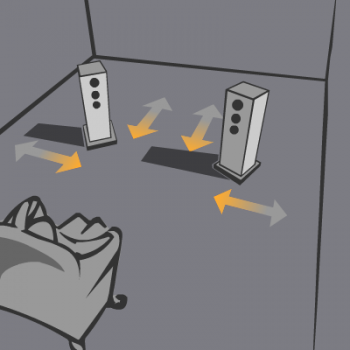
The speakers are to be placed well into the room in order to maximise the delay of reflections and to remove their effects from the sphere of spatial perception.
The perfect and most effective distance lies between 85 cm (33 in) and 1.5 m (5 ft) – depending on the listener’s position. However, you can also obtain very good results at a distance of 70 cm (28 in). An easy way to home in on the right distance is to sit down in the listening seat and ask a friend to hold up a mirror and move it along the wall. As soon as you see the speaker in the mirror, you know where the acoustic reflection comes from. Now measure the distance between the speaker and mirror, and mirror and listening seat, then subtract the distance between the speaker and listening seat. You will see from the result whether you are above or below the critical distance of 1.7 m (5.6 ft).
If you are well below this value, you can try to dampen or diffuse critical room resonances in order to reduce their effects. In the case of dampening critical resonances, part of the energy is destroyed by friction. For instance, heavy fabrics can be hung a few centimetres from the wall which dampen the reflections. If you want to go a step further, you can even use special dampening material. In this case we recommend that you use the heavier material. We can assure you that an area of 1 m (3.3 ft) height and 0.5 m (1.6 ft) width put on the reflection point may produce astounding results. In the case of diffusing critical resonances, the sound should be reflected in different ways. A shelf with many books of different sizes can do the trick. However, you can also buy so-called diffusers, specially designed for the diffusion of sound waves.
Let us say another word about the general concept of spatial perception. If you enter a completely dark room, you will immediately know the approximate size of the room even though you cannot see to orient yourself. You therefore rely on spatial information and relate to small sounds. The knowledge we have obtained about the size of a room generally helps to prevent that we perceive sound from music reproduction as something coming “from behind” the back wall.
If you attach importance on an excellent low-frequency performance, we recommend that you leave enough space between the speakers and the back wall.
Leave enough space between the speakers and the wall!
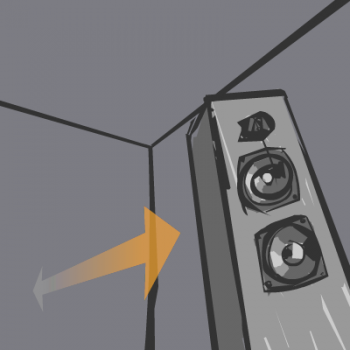


Before we finish the topic of determining the precise spacing from the walls, we would like to add that the space between the wall and speakers also has a deep impact on the bass performance. If you place your speakers or the listening seat closer to the wall, you have to expect a stronger bass response. However, the distances between the speakers, and the back and side walls should never be the same. At least a ratio of 1 : 1.3 is recommended.
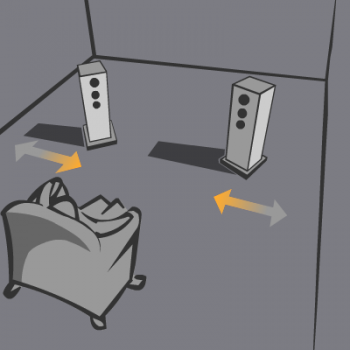


Some positional experimentation should be performed around this point (wall distance of speakers and/or listening seat) in order to achieve personal control of sound balance.
Unfortunately, there is more to consider than just a few first reflections in a room. A sound event is reflected from every surface in the room and every new resonance is reflected, as is every following resonance etc. After a fraction of a second several thousand millions of reflections can exist in an average-sized living room. Naturally, every new generation of reflections loses some of its energy compared to the previous generation, and yet their number is ever increasing. In the following illustration this so-called reverberation is shown.
Here you can see the sound pressure, sound event and reflections in a listening room of 30 m_ (320 sq. ft.).
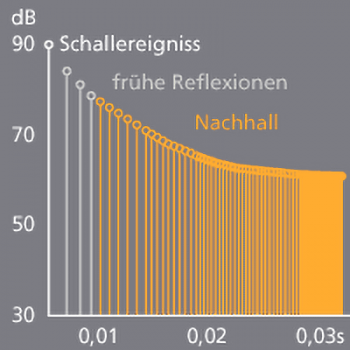


The volume created by the direct sound of a loudspeaker is reduced by half with each doubling of the distance, whereas the reverberation sound is the same everywhere in the room. From a certain distance, this can result in the reflected sound being dominant over the direct sound from the loudspeakers. Acousticians refer to the distance to the loudspeakers, or better to say the radius of the speakers, as the reverberation radius. The reverberation radius can amount to approximately two meters (6.6 ft) in an average-sized listening room. We presume that you prefer to enjoy the direct sound of your favourite piece of music rather than listen to the reflected sound, therefore we would like to draw your attention to rule no. 4.
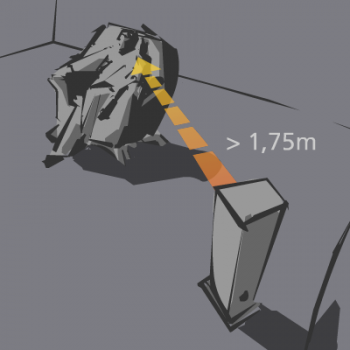


The closer your listening position is to the loudspeakers, the lower the level of room-dependent sound production you will be exposed to. However, you should keep a minimum distance of 1.75 m (5.7 ft) in order to let the sound fields from the drives add up correctly.
In the case of large and powerful loudspeakers which are not necessarily optimised for a short-range placement, you can choose an even greater minimum distance. If your listening room allows listening distances of more than 2 meters (6.6 ft), we suggest a very careful approach to furnishing this room. You should bear in mind that each and every object partially dampens the reflected sound waves and that the amount of dampening depends on the frequency. Unfortunately, virtually everything can dampen high frequencies, e.g. curtains, carpets, seats and sofas. Low frequencies, on the other hand, are only dampened by cupboards or large windows. This can easily lead to an non-proportionate dampening of high frequencies which usually results in a lifeless and boomy sound.
The removing of unnecessary high-frequency killers, e.g. by drawing the curtains, can result in a more dynamic sound. We recommend that you use dampening material sparingly and only in the case of real disturbances.
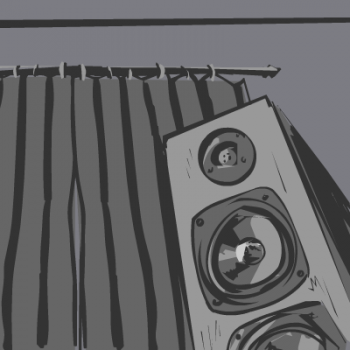


Remember to do so if you want to avoid the above-mentioned first reflections and possible flutter echoes. Flutter echoes normally occur in sparsely furnished rooms when the sound reflects between the upper walls before reaching the listener’s ear at nearly full force. If the sound has travelled approximately 30 m (100 ft), it is perceived by our brain as a new sound event.



Clap your hands in order to see if flutter echoes exist in your room. If this is the case, place a few small cushions in the corners of the room and in the corners between the wall and the ceiling.
Now we are coming to the most complicated topic with regards to the correct positioning of the loudspeakers: standing waves. Standing waves are sound waves whose fixed distribution in space is a multiple of half the wall distance. Standing waves extend the bass response and make it less precise as they unnaturally prolong the dying-out transient. The best solution on how to avoid this effect is to build a room with an optimised ratio between width, height and depth.
This ratio, however, always depends on and changes according to the room size, and most of us are not in a position to just choose the room proportions anyway. What can be done? We will leave aside the possibility to furnish the listening room with absorbers specially designed for the frequencies of single standing waves. (In any case, the author has never come across a listening room furnished with such absorbers.) Standing waves are especially strong if either the loudspeaker or the listener is located next to one of the walls between which a standing wave can occur. You may take this as a further reason for placing the speakers well into the room.
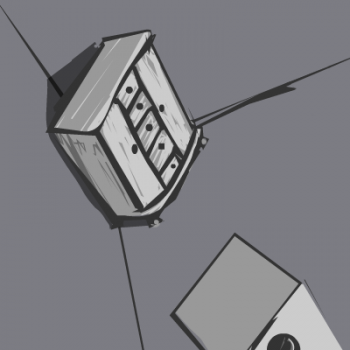


If this is simply impossible, we recommend that you furnish the corners of your room with various pieces of furniture, tube traps or monoliths made by Room Tune. The furnishing should be roughly one meter wide and at least one meter high.
We also recommend that you dampen standing waves by placing a few objects throughout the room.
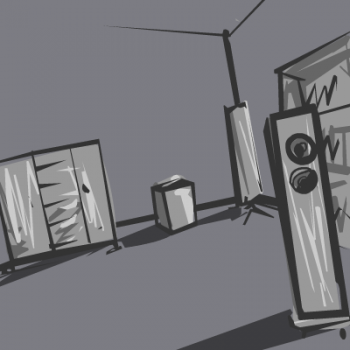


In the case of stereophonic reproduction of sound and symmetrical arrangement of the speakers, you will succeed in dampening standing waves between the left and the right wall. This is due to the fact that low frequencies generally blend together in recorded music. When you look at the front and back wall and the floor and ceiling, you will see the speakers are placed in one line.
If you encounter any problems with this set-up, you may consider adding a subwoofer, which should not be placed in line with the speakers. In a worst case situation (walls made of rigips or plasterboard, ceiling and floor made of concrete), this could mean placing the subwoofer on a higher level, halfway between the floor and the ceiling, in order to obtain optimum results. An arrangement to the left or right of a corner and not collateral to a wall can also dampen standing waves. However, in the case of such arrangements it has often turned out to be quite difficult to obtain a symmetrical sound stage. If you do succeed in obtaining such a sound stage, you are well rewarded with a fully-balanced bass response.
Finally, we deal with the question on how to determine the right distance between the speakers. In the early days of stereophonics, the equipment was set up according to the principle of an isosceles triangle, i.e. equal spacing between the speakers and the listener. Today, we can definitely regard this approach as outdated. In those days, especially in America, the former stereophonic records were done with two microphones spaced several meters apart. If the speakers were spaced too far apart, an acoustic hole could be perceived in the middle. With today’s records we rarely encounter this problem. Either the distance between the microphones lies between 0 cm (0.00 in) and one meter (3.3 ft), or every single instrument has a microphone of its own. Where these instruments are heard, is decided in the studio. Research carried out at Audio Physic has proved that an apex angle of 75 ° between listener and speakers has no negative effects, providing that the set-up of the music system is correct.
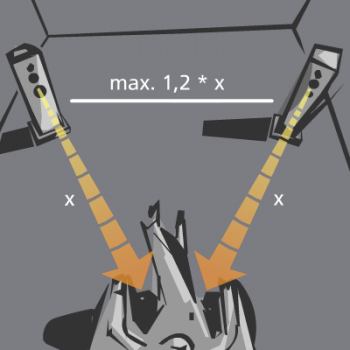


This means that for your set-up that the distance between the speakers can be 1.2 times as much as the distance between the speakers and the listener.
All of this, results in a large sound stage, and every single instrument is better separated from the others in terms of room space. Just for your information: you pay 20 % more for a television set with a larger screen (larger by 17 %), however you get 20% more sound stage virtually free as a reward for an effective loudspeaker set-up.